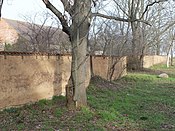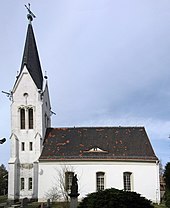Gottscheina
Gottscheina is a district in the northeast of Leipzig and a formerly independent municipality. Today the place is a district of Leipzig and belongs to the district Seehausen in the city district north.
Location and local characteristics
Gottscheina is the northernmost district of Leipzig. It is located about twelve kilometers to the northeast from the city center in an agricultural area and is only connected to the urban area by the road to Hohenheida . The streets coming from the neighboring towns of Mutzschlena, Pönitz and Merkwitz (all of them to Taucha ) unite at the edge of the town, into which only one street leads, so that it is spared from through traffic. Gottscheina is loosely connected to the Leipzig public transport network via a few trips on bus lines 86 (Neue Messe) and 176 (Taucha) .
The buildings are mostly three- and Gottscheinas Vierseithof, as in the southern part Rundling around the village pond (also spring pool ) group and form a dead end like extension to the north. The church stands between the two parts .
Numerous buildings are built using the clay construction method; the oldest, the residential building in courtyard no. 10, dates from 1768 and is a seldom found two-story plastered clay corrugated building , the outer walls of which taper from 1.3 m on the ground floor to 0.6 m on the upper floor. Large parts of the clay wall that once enclosed the entire village have been preserved.
To the west of the village are two ponds in a wood, from whose pits the clay for building houses was extracted. The wood offers shelter from the wind in the otherwise forest-free area and has been protected since time immemorial so that every felled tree had to be replaced by new plantings. The former source of the village pond has dried up. He is now fed by the collected rain runoff water of the place. Its overflow leads, piped up to the surrounding wall, into the Hasengraben , which flows into the Parthe at Plaussig .
history
The founding of Gottscheinas as a Rundling by Slavic settlers is assumed for the 8th century. It was first mentioned in a document in 1305 in connection with a Timo de Gotschene. The northern street-like extension of the village is assumed for the 15th century and is associated with the desolation of the northwestern village of Nelmitz , as the peasants probably also came to Gottscheina with the associated corridor.
In 1438 on suitable Elector Friedrich II. Of Saxony and his brother Wilhelm of the University of Leipzig the suzerainty over the villages Merkwitz , Hohenheida and Gottscheina, now University of villages were called and managed to in the mid-19th century by the university.
The small church of Gottscheinas, probably based on Romanesque origins, was first mentioned in writing in 1637 when Swedish mercenaries placed their horses in it during the Thirty Years' War . After being destroyed several times, it was rebuilt on the remains. It received its striking tower from a donation in 1892. When it was supposed to be demolished in 1969 due to its dilapidation, the villagers saved it through donations and work. In the second half of the 19th century, an inn and a school were built on the road west of the core village.
Until 1856, Gottscheina belonged to the Electoral Saxon or Royal Saxon District Office in Leipzig . In 1856 the place came to the Taucha court office , in 1875 to the Leipzig administrative authority , in 1952 to the Leipzig-Land district in the Leipzig district and in 1994 to the Leipziger Land district . In 1957 Gottscheina was incorporated into Hohenheida , with this in 1992 in Seehausen and in 1997 in Leipzig.
Since the village corridor was classified as a reserved area for a planned open- cast lignite mine in the years 1970–1990 , new buildings in the village had to be avoided during this time. After the fall of 1989/1990, numerous buildings were renovated, and a small new residential area was built next to the old village in the south. In 1995, a monument preservation framework plan was drawn up for Gottscheina to preserve the town's character , and all farmsteads and the church were placed under monument protection.
Personalities
- The Leipzig machine manufacturer Karl Krause (1823–1902) married Emilie Polter (1835–1911) from Gottscheina in 1857 and in 1892 donated the new construction of the church tower.
- The journalist Udo Reiter (1944–2014), co-founder of Mitteldeutscher Rundfunk (MDR) and its director from 1991 to 1994, lived in the former school in Gottscheina from 1994 and died here too.
literature
- Vera Danzer, Andreas Dix: Leipzig - A regional history inventory in the Leipzig area . Ed .: Haik Thomas Porada . 1st edition. Böhlau, Cologne Weimar Vienna 2015, ISBN 978-3-412-22299-4 , pp. 237/238 .
- Christoph Kühn, Heidemarie Epstein: Gottscheina, Hohenheida, Göbschelwitz. A historical and urban study. Pro Leipzig e. V. (ed.). Leipzig 1999.
- Cornelius Gurlitt : Gottscheina. In: Descriptive representation of the older architectural and art monuments of the Kingdom of Saxony. 16. Issue: Amtshauptmannschaft Leipzig (Leipzig Land) . CC Meinhold, Dresden 1894, p. 26.
- Gottscheina . In: August Schumann : Complete State, Post and Newspaper Lexicon of Saxony. 3rd volume. Schumann, Zwickau 1816, p. 369.
Web links
- Gottscheina in the Digital Historical Directory of Saxony
Individual evidence
- ↑ Gottscheina, Hohenheida, Göbschelwitz , p. 19
- ↑ a b Gottscheina, Hohenheida, Göbschelwitz , p. 14
- ^ Karlheinz Blaschke , Uwe Ulrich Jäschke : Kursächsischer Ämteratlas. Leipzig 2009, ISBN 978-3-937386-14-0 ; P. 60 f.
- ↑ Gottscheina district. In: Seehausen local council. Retrieved May 6, 2020 .
- ↑ Martin U. Müller : On the death of Udo Reiter: A cheerful fighter. In: Spiegel Online . October 10, 2014, accessed May 6, 2020 .
Coordinates: 51 ° 25 ′ 33 ″ N , 12 ° 28 ′ 53 ″ E



